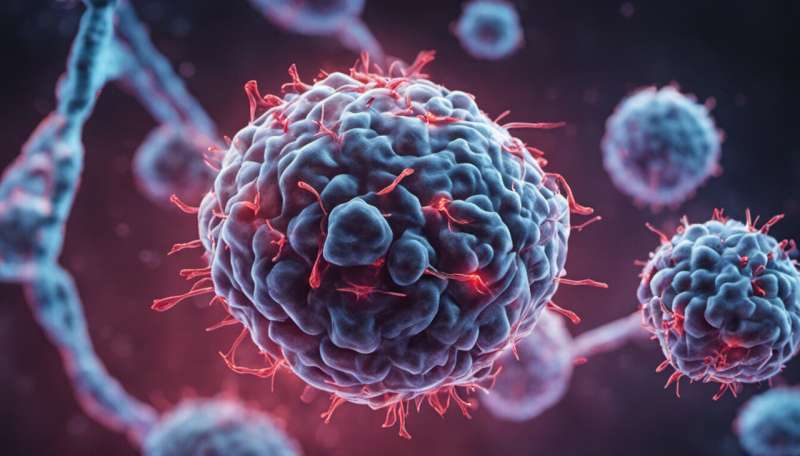This article has been reviewed according to Science X's editorial process and policies. Editors have highlighted the following attributes while ensuring the content's credibility:
fact-checked
peer-reviewed publication
trusted source
proofread
Tumor Metabolism Atlas offers a new way to discover cancer mechanisms

An atlas that catalogs gene activity and the levels of small molecules called metabolites in tumor samples offers a new way of identifying the deep mechanisms of cancer, according to researchers at Weill Cornell Medicine and Memorial Sloan Kettering Cancer Center.
The researchers, who published their work June 19 in Nature Metabolism, created the Cancer Atlas of Metabolic Profiles (CAMP) by combining new and existing datasets on metabolites and gene activity. The Atlas contains data from 988 tumor and normal-tissue control samples across 11 different cancer types. The scientists' analysis of the data revealed two broad classes of gene-metabolite connections that point to mechanisms at work across cancer types.
"This new atlas will help us build a core understanding of how tumors function," said study co-senior author Dr. Jan Krumsiek, assistant professor of physiology and biophysics and a member of the Sandra and Edward Meyer Cancer Center at Weill Cornell Medicine.
"Our work addresses the basic question of how changes to metabolite levels and gene expression levels are coordinated," said the other study co-senior author, Dr. Ed Reznik, a computational biologist at Memorial Sloan Kettering Cancer Center. "The answer we deliver is beautiful and nuanced: this coordination emerges in tandem from the molecular action of genetically-encoded enzymes and their metabolite substrates, as well as from the presence of metabolically unique immune cells in the tumor microenvironment."
The co-first authors of the study were Dr. Elisa Benedetti, a research associate during the study in the Krumsiek lab; and Dr. Eric Liu, a research fellow, and Dr. Cerise Tang, a graduate student in the Reznik lab at the time of the study.
Metabolites are small organic molecules used in or produced by metabolic processes in tissues and the bloodstream. They often work in biochemical reactions that provide energy to cells, or serve as building blocks for proteins, sugars, lipids, DNA and RNA.
The pattern of metabolite levels in tissues is one of the important layers of information in biology, and researchers already know that key events in cancer, such as tumor development and the acquisition of drug resistance, are accompanied by significant changes in metabolites. Relating these cancer-associated metabolite changes to changes in gene activity helps scientists understand why these metabolite changes occur—for example, which enzymes or other proteins are driving the changes. In some cases, disrupting those mechanisms could help fight the cancer.
The CAMP database the scientists created is meant facilitate such analyses, for it is the largest-ever harmonized collection of data on metabolite and gene-activity levels in primary tumor samples. Putting it together was a serious challenge, though.
"The methods used in studies of metabolites have been much less standardized than the methods in, say, RNA sequencing studies," Dr. Krumsiek said. "It's often the case that two different cancer metabolite studies won't measure the same set of metabolites, and even the metabolites that are measured in both studies will sometimes have different names in the datasets."
Having painstakingly aligned the disparate features of the individual datasets, the scientists sought clues to broad cancer mechanisms by looking for gene-metabolite relationships that were prominent across all cancer types covered in the database.
One pattern they found was expected: Some metabolites were strongly correlated with genes encoding enzymes and other proteins with roles in producing metabolites or otherwise regulating their levels. Identifying genes that control cancer-associated metabolite levels can help in further investigations of these metabolites' possible roles in driving cancer, Dr. Krumsiek said.
In the other prominent pattern the team discovered, some metabolites were strongly linked to the activities of broad sets of genes—genes not clearly related to metabolite production and processing. Looking closely at the genes involved, Drs. Krumsiek and Reznik realized that this pattern likely reflected the presence of immune cells, which commonly infiltrate solid tumors.
"It appears that immune cells are massively impacting the metabolite profiles of these tumor samples," Dr. Krumsiek said.
The results underscore the importance of understanding the contributions of different cell types in tumor samples, he added. To that end, he and Dr. Reznik and their teams now plan to move to more advanced techniques that can "map" gene activity and metabolite levels at precise locations across tumor samples.
More information: Elisa Benedetti et al, A multimodal atlas of tumour metabolism reveals the architecture of gene–metabolite covariation, Nature Metabolism (2023). DOI: 10.1038/s42255-023-00817-8




















